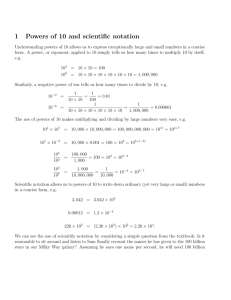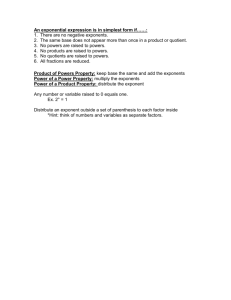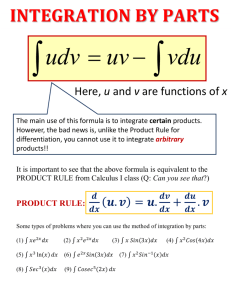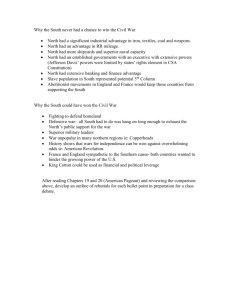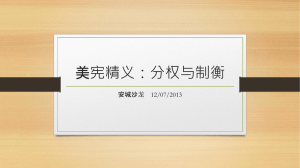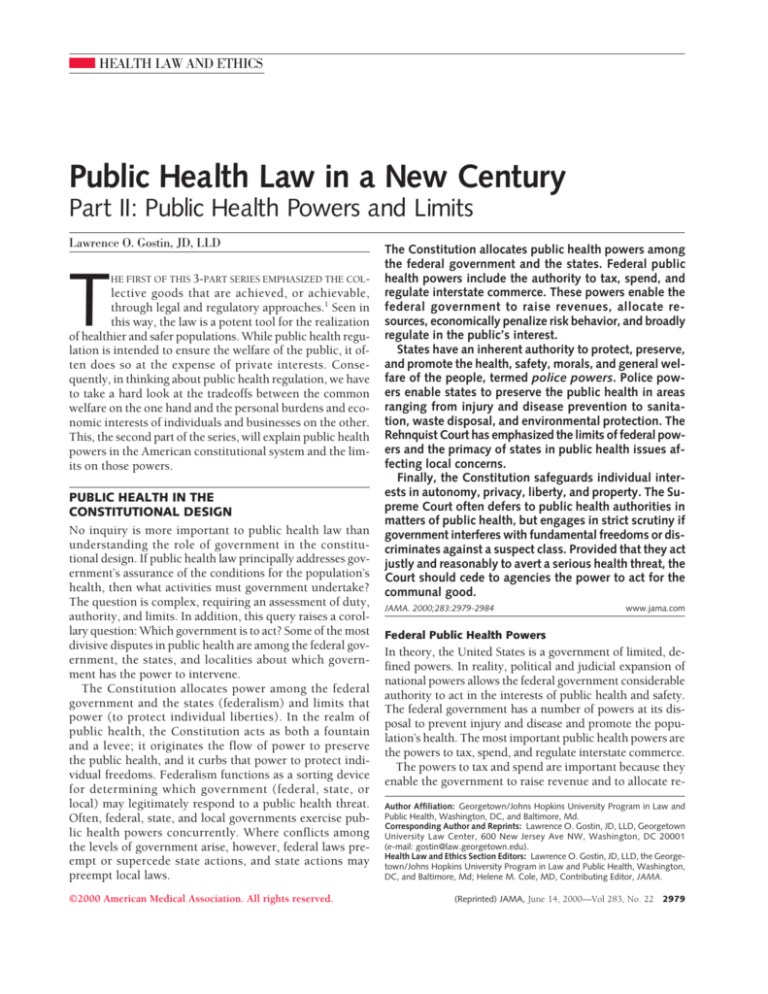
HEALTH LAW AND ETHICS
Public Health Law in a New Century
Part II: Public Health Powers and Limits
Lawrence O. Gostin, JD, LLD
T
HE FIRST OF THIS 3-PART SERIES EMPHASIZED THE COL-
lective goods that are achieved, or achievable,
through legal and regulatory approaches.1 Seen in
this way, the law is a potent tool for the realization
of healthier and safer populations. While public health regulation is intended to ensure the welfare of the public, it often does so at the expense of private interests. Consequently, in thinking about public health regulation, we have
to take a hard look at the tradeoffs between the common
welfare on the one hand and the personal burdens and economic interests of individuals and businesses on the other.
This, the second part of the series, will explain public health
powers in the American constitutional system and the limits on those powers.
PUBLIC HEALTH IN THE
CONSTITUTIONAL DESIGN
No inquiry is more important to public health law than
understanding the role of government in the constitutional design. If public health law principally addresses government’s assurance of the conditions for the population’s
health, then what activities must government undertake?
The question is complex, requiring an assessment of duty,
authority, and limits. In addition, this query raises a corollary question: Which government is to act? Some of the most
divisive disputes in public health are among the federal government, the states, and localities about which government has the power to intervene.
The Constitution allocates power among the federal
government and the states (federalism) and limits that
power (to protect individual liberties). In the realm of
public health, the Constitution acts as both a fountain
and a levee; it originates the flow of power to preserve
the public health, and it curbs that power to protect individual freedoms. Federalism functions as a sorting device
for determining which government (federal, state, or
local) may legitimately respond to a public health threat.
Often, federal, state, and local governments exercise public health powers concurrently. Where conflicts among
the levels of government arise, however, federal laws preempt or supercede state actions, and state actions may
preempt local laws.
©2000 American Medical Association. All rights reserved.
The Constitution allocates public health powers among
the federal government and the states. Federal public
health powers include the authority to tax, spend, and
regulate interstate commerce. These powers enable the
federal government to raise revenues, allocate resources, economically penalize risk behavior, and broadly
regulate in the public’s interest.
States have an inherent authority to protect, preserve,
and promote the health, safety, morals, and general welfare of the people, termed police powers. Police powers enable states to preserve the public health in areas
ranging from injury and disease prevention to sanitation, waste disposal, and environmental protection. The
Rehnquist Court has emphasized the limits of federal powers and the primacy of states in public health issues affecting local concerns.
Finally, the Constitution safeguards individual interests in autonomy, privacy, liberty, and property. The Supreme Court often defers to public health authorities in
matters of public health, but engages in strict scrutiny if
government interferes with fundamental freedoms or discriminates against a suspect class. Provided that they act
justly and reasonably to avert a serious health threat, the
Court should cede to agencies the power to act for the
communal good.
JAMA. 2000;283:2979-2984
www.jama.com
Federal Public Health Powers
In theory, the United States is a government of limited, defined powers. In reality, political and judicial expansion of
national powers allows the federal government considerable
authority to act in the interests of public health and safety.
The federal government has a number of powers at its disposal to prevent injury and disease and promote the population’s health. The most important public health powers are
the powers to tax, spend, and regulate interstate commerce.
The powers to tax and spend are important because they
enable the government to raise revenue and to allocate reAuthor Affiliation: Georgetown/Johns Hopkins University Program in Law and
Public Health, Washington, DC, and Baltimore, Md.
Corresponding Author and Reprints: Lawrence O. Gostin, JD, LLD, Georgetown
University Law Center, 600 New Jersey Ave NW, Washington, DC 20001
(e-mail: gostin@law.georgetown.edu).
Health Law and Ethics Section Editors: Lawrence O. Gostin, JD, LLD, the Georgetown/Johns Hopkins University Program in Law and Public Health, Washington,
DC, and Baltimore, Md; Helene M. Cole, MD, Contributing Editor, JAMA.
(Reprinted) JAMA, June 14, 2000—Vol 283, No. 22
2979
PUBLIC HEALTH LAW
sources for the public’s health. Resource allocation, of course,
can be highly contentious as evidenced by contemporary debates about spending money from the tobacco settlement.
The taxing power also provides a powerful means to regulate, both directly and indirectly, private activities that endanger health. Tax relief provides incentives for private activities that government views as advantageous to public
health (eg, employer-sponsored health care). Taxation also
regulates private behavior by economically penalizing
risk-taking activities (eg, taxes on tobacco and alcoholic
beverages).
Similarly, the spending power does not merely provide
Congress with independent authority to allocate resources
for the public good; it also allows Congress to set conditions on the receipt of funds.2 The need for federal public
health funds effectively induces state conformance with federal regulatory standards. Congress uses conditional spending to induce states to conform to federal standards in numerous public health contexts, including Medicaid and
Medicare, occupational health, and highway safety.
Of all the provisions bestowing federal public health power,
none is more important than Article 1, §8 of the Constitution, which grants Congress the power to “regulate Commerce . . . among the several States.” Practically speaking,
the power to regulate commerce has enabled the national
government to invade traditional realms of state authority
including environmental protection, occupational health,
food and drug purity, and safe drinking water. The Court’s
modern construction of the power to regulate commerce has
been described as plenary or all-embracing, and has been
exerted to affect virtually every aspect of social life.3
State Police Powers
Despite the broad federal presence, states and localities have
a predominate role in population-based health services. The
Tenth Amendment reserves to the states all powers that are
neither given to the federal government nor prohibited by
the Constitution. These reserved powers include, most importantly, the police power to promote the general welfare
of society. The police power evokes images of an organized
civil force for maintaining public order. But the origin of
the word and definition of police (politic means state; polis
means city; and politeia means citizenship)4 is far more textured. The police power in early American life was part of a
well-regulated society, a “science and mode of governance
where the polity assumed control over, and became implicated in, the basic conduct of social life.”5(p14) I define police powers as:
The inherent authority of the state (and, through delegation, local government) to enact laws and promulgate regulations to protect, preserve, and promote the health, safety, morals, and general welfare of the people. To achieve these communal benefits,
the state retains the power to restrict, within federal and state constitutional limits, personal interests in liberty, autonomy, privacy, and expression, as well as economic interests in freedom of
contract and uses of property.
2980 JAMA, June 14, 2000—Vol 283, No. 22 (Reprinted)
Police powers include all laws and regulations directly or
indirectly intended to improve morbidity and mortality in
the population. Police powers have enabled states and localities to promote and preserve the public health in areas
ranging from injury and disease prevention to sanitation,
waste disposal, and water and air pollution. Police powers
authorize curtailment of personal freedoms, such as bodily
integrity (eg, mandatory vaccination, screening, physical examination, and directly observed therapy), privacy (eg, reporting and partner notification), and liberty (eg, isolation
and quarantine). Police powers also authorize curtailment
of proprietary freedoms including inspections, licenses, nuisance abatements, and zoning.
States exercise police powers for the common good, that
is, to ensure that communities live in safety and security,
in conditions conducive to good health, with moral standards, and, generally speaking, without unreasonable interference with human well-being. Government, to achieve
common goods, is empowered to legislate, regulate, and adjudicate in ways that necessarily limit, or even eliminate,
private interests. Thus, government has inherent power to
interfere with personal interests in autonomy, privacy, liberty, and expression, as well as economic interests in ownership and uses of private property. The police power affords states the authority to keep society free from noxious
exercises of private rights, such as the dumping of toxic waste.
New Federalism
Since the founding of the Republic, the division of federal
and state powers has been important and highly controversial. The Supreme Court, at least since Roosevelt’s New Deal,
has liberally interpreted national powers leading to an expansion of federal public health authority. More recently,
however, the Rehnquist Court has emphasized the limits on
Congress’ powers. Known as new federalism, federal courts
have begun to hold that federal police powers should be circumscribed, with more authority returned to the states.6
The Supreme Court has narrowed the scope of the commerce power by holding that the federal government cannot
regulate purely intrastate activities. In United States v Lopez,7
the Court held that Congress exceeded its commerce clause
authority by making gun possession within a school zone a
federal offense. In addition to Lopez, the Court has held in a
series of cases that Congress, even if empowered to act for the
public good, must exert its authority in ways that do not excessively intrude on state sovereignty. In New York v the United
States,8 the Supreme Court struck down a federal statute providing for the disposal of radioactive waste as violating the Tenth
Amendment. The Court used the same reasoning to overturn
provisions in the Brady Handgun Violence Prevention Act,
which directed state and local law enforcement officers to conduct background checks on prospective handgun purchasers.9 During its current term, the Supreme Court also is likely
to strike down the Violence Against Women Act as an unconstitutional exercise of the power to regulate commerce.10
©2000 American Medical Association. All rights reserved.
PUBLIC HEALTH LAW
At the same time, the Supreme Court has not allowed the
federal government to abrogate the states’ sovereign immunity. This means that Congress (when acting within its commerce powers) may not authorize private individuals to sue
states. The Rehnquist Court perceives the states’ immunity
from lawsuits to be a fundamental precept of sovereignty:
“Federalism requires that Congress accord States the respect and dignity due them as residuary sovereigns and joint
participants in the Nation’s governance.”11 The Court’s sovereign immunity jurisprudence is most important in the area
of civil rights laws, where Congress has authorized individuals to sue states for discrimination. For example, in its
2000 term, the Court held that the federal government could
not authorize private lawsuits against the states under the
Age Discrimination in Employment Act.12 More state sovereign immunity decisions are expected that could undermine civil rights laws, such as the Americans with Disabilities Act and the Individuals with Disabilities Education Act.
These laws have important public health effects because they
require government to exercise public health and other powers on a nondiscriminatory basis.
With these decisions on national commerce powers, statereserved powers, and sovereign immunity, the Rehnquist
Court has been defending traditional states’ rights against
federal political domination. But beyond the jurisprudential debate about the most appropriate level of government
in a federal system lies an important question about the population’s health and safety. If the states do not act effectively
or uniformly to reduce health threats such as firearms, cigarettes, or pollution, will the judiciary permit national authorities to exercise a police function? The current Supreme Court may impede the federal government’s power
to act for the health of the population.
CONSTITUTIONAL LIMITS:
INDIVIDUAL RIGHTS AND FREEDOMS
Police powers are vitally important for the public’s health
and safety, but also intrude on a sphere of personal freedom. As the following discussion shows, constitutional rights
are not neutral, objective, and consistent, but are influenced by culture, society, and politics; and notions of rights
change over time as the composition of the judiciary shifts.
Early Constitutional Law and the Social Contract
While the Constitution does not explicitly mention public
health, it does recognize the right of states to execute inspection laws, which were incident to quarantines.13 Chief Justice John Marshall, as early as 1824, suggested that states have
inherent and pervasive authority to safeguard the public’s
health.14 For more than a century after the Marshall Court,
the judiciary remained highly deferential to the exercise of
public health powers.15,16 The major impetus for judicial activity in the public health field was the sporadic occurrence
of epidemics of leprosy, smallpox, scarlet fever, cholera, venereal disease, and tuberculosis. In this context, private rights
©2000 American Medical Association. All rights reserved.
were subordinated to the public interest, and individuals were
seen as bound to conform their conduct for society’s good.
As one court put it, police powers do not frustrate personal
rights because there is no liberty to harm others.17
Early constitutional law was heavily influenced by ideas
of the social contract in which citizens hold duties to one
another and to the society as a whole. In the foundational
case of Jacobson v Massachusetts,18 decided in 1905, the Supreme Court upheld compulsory vaccination, finding that
it was a reasonable exercise of the police power. Justice John
Marshall Harlan conveyed this sense of community:
[T]he liberty secured by the Constitution . . . does not import an
absolute right in each person to be . . . wholly freed from restraint. There are manifold restraints to which every person is necessarily subject for the common good. On any other basis organized society could not exist with safety to its members. . . . A
fundamental principle of the social compact is that the whole people
covenants with each citizen, and each citizen with the whole people,
that all shall be governed . . . for the common good.
The judiciary, even during the early 20th century, did assert
some control over public health powers. The courts, following a “rule of reasonableness,” insisted that states must not
act in “an arbitrary, unreasonable manner.”18 In practice, however, this standard left basic questions unanswered: how was
rationality or necessity to be judged? For example, a New York
court left the question of necessity to the people.19
In examining the case law of the early 20th century, 3 limits on compulsory powers can be identified, although the
courts were not always clear or consistent. First, public health
authorities had to demonstrate that the subject was actually infectious and posed a public risk.20 The courts appeared hesitant to stigmatize citizens in the absence of reasonable proof. Even here, however, social prejudice often
provided the principal basis for action. One court said that
“all known prostitutes and people associated with them shall
be . . . suspected of having a venereal disease.”21 And another court accepted the unfounded assumption that “suspected” prostitutes were “natural subjects and carriers of venereal disease,” making it “logical and natural that suspicion
be cast upon them.”22
Second, the exercise of police powers should not be harmful to the individual. This freedom-from-harm principle is
based on the theory that public health powers are designed
to promote well-being—and not to inflict punishment. For
example, authorities could not demand that a hypersensitive person receive a vaccination,18 but they could ensure
that patients have a safe and habitable environment during
isolation or quarantine.17
Third, public health authorities should not exercise their
powers on racial or other discriminatory grounds. For example, one of the most invidious measures in public health
history was struck down in Jew Ho v Williamson,23 which
was decided in 1900. Public health officials in San Francisco quarantined an entire district with more than 15000
persons, ostensibly to contain an epidemic of bubonic plague.
(Reprinted) JAMA, June 14, 2000—Vol 283, No. 22
2981
PUBLIC HEALTH LAW
However, in doing so the quarantine was made to operate
exclusively against the Chinese community. The court invalidated the quarantine because authorities acted with “an
evil eye and an unequal hand.”23 Jew Ho serves as a reminder that public health powers sometimes can be used
as an instrument of prejudice and subjugation.
Constitutional Rights in the Modern Era
The Supreme Court changed markedly during the 2 decades beginning in the late 1950s. This was a time when the
ideology of rights and freedoms became salient: the civil rights
movement for blacks, protests against the Vietnam War, and
the reemergence of feminism. Responding to these and other
social movements, the Warren Court revitalized and strengthened the Court’s position on issues of equality and civil liberties.24 The Warren Court set a liberal agenda that prized
personal freedom, equality, and justice.
The modern Court continues its permissive approach in
most matters of public health, but engages in strict scrutiny if the policy (1) discriminates against a suspect class,
such as a racial minority, or (2) invades a fundamental right,
such as the right to travel25 or to bodily integrity.26 Under
strict scrutiny, the exercise of compulsory powers will be
invalidated unless the state can demonstrate a compelling
interest, a close connection between means and ends, and
that the intervention is the least restrictive alternative. The
state also has to provide rigorous procedural safeguards. For
example, one state Supreme Court held that public health
authorities must provide a fair hearing for persons subject
to isolation or quarantine.27
The Court is likely to reserve its heightened level of scrutiny only for the most intrusive or discriminatory public
health powers: interventions that discriminate on the basis
of race or gender or deprive persons of their liberty (eg, quarantine) or bodily integrity (eg, compulsory treatment). Even
where it applies heightened scrutiny, courts are likely to uphold public health actions that are exercised fairly and are
necessary to avert a significant risk. For example, courts permit isolation to prevent transmission of infectious disease.28 Further, the courts permit mandatory treatment (including directly observed therapy for tuberculosis) to avert
a risk to self or others and in cases when the treatment is
medically beneficial to the patient.29 The courts are unlikely to apply strict scrutiny to less-intrusive interventions that invade bodily integrity, such as compulsory vaccination30 and testing.31 For most other public health powers,
such as reporting and partner notification, the courts adopt
a deferential approach.32
departments to license tradespersons and professionals (eg,
physicians and nurses), regulate public health institutions
(eg, hospitals and nursing homes), inspect premises and businesses (eg, restaurants and tattoo parlors), zone commercial and residential areas (eg, to prevent certain land uses),
and abate nuisances (eg, infestations or fire hazards). Indirect regulation through the tort system also curtails economic interests (eg, pervasive litigation against manufacturers of motor vehicles, cigarettes, and firearms). These
direct and indirect regulatory powers interfere with the interests of businesses, professionals, and land owners in pursuing their occupations and livelihoods.
The Constitution protects economic liberties as evidenced by several provisions. Notably, the Constitution forbids the government from depriving persons of property (or
life or liberty) without due process of law (economic due
process), impairing the obligations of contracts (freedom
of contract), and taking private property for public use without just compensation (takings). Despite these safeguards,
the framers of the Constitution never intended to permit private property interests to triumph over legitimate community interests in health and safety.
Economic Due Process
Conservative scholars argue that economic liberties are important in the constitutional design and observe that the Supreme Court has, at times, strongly defended commercial
relationships.33 However, on careful reflection, the Court has
more often seen public health regulation as a sufficient justification for government infringement of economic freedom. Indeed, when the Supreme Court came to examine a
challenge to sanitary regulation of slaughter houses in 1873,
it said that government had the undoubted power to restrict occupational freedoms for the common good.34,35
In 1905, the Supreme Court decided a now infamous case
called Lochner v New York36 in which it held that a law limiting the hours that bakers could work violated the due process clause of the Fourteenth Amendment. The Court perceived a limitation on bakers’ hours as an interference with
the freedom of contract rather than as a legitimate police power
regulation. The Lochner era from 1905 to 1937 was a time
when the Court valued and protected economic freedoms and
aggressively invalidated numerous attempts at social and economic regulation. The Court, however, overruled Lochner during Roosevelt’s New Deal. Since that time, the judiciary has
granted public health regulation a presumption of validity even
if it interferes with economic and commercial life.
Freedom of Contract
ECONOMIC LIBERTY
AND THE PURSUIT OF PUBLIC HEALTH
Public health powers do not merely invade personal interests in autonomy, liberty, and privacy. The regulatory techniques of public health also interfere with economic liberties. Consider the broad authority of state and local health
2982 JAMA, June 14, 2000—Vol 283, No. 22 (Reprinted)
Public health regulation often interferes with the freedom
of contract. For example, occupational health and safety laws
interfere with free bargaining among employers and workers, and consumer protection laws interfere with free bargaining among manufacturers and buyers. Some scholars
assert that the constitutional right of freedom of contract
©2000 American Medical Association. All rights reserved.
PUBLIC HEALTH LAW
should safeguard these kinds of economic relationships. Nevertheless, the Supreme Court has narrowly interpreted the
contracts clause. The clause applies only to state, not federal, regulation, only to existing, not future, contracts.37 Moreover, even if public health regulation affects an existing contract (which is rare), the Supreme Court has emphasized
that the police power “is an exercise of the sovereign right
of government to protect the lives, health, morals, comfort, and general welfare of the people, and is paramount to
any rights under contracts between individuals.”38
Regulatory Takings
The government has the power of eminent domain, which
is the authority to confiscate private property for a governmental activity. However, the Fifth Amendment imposes a
significant constraint on this power by requiring just compensation for private property taken for a public use. The
theory behind the takings clause is that individuals should
not have to bear public burdens that should be borne by the
community as a whole. Consequently, the takings clause is
about government spreading loss when pursuing the
public interest.
Despite its just purposes, an expansive interpretation of
the takings clause would shackle public health agencies by
requiring them to provide compensation whenever regulation significantly reduces the value of private property. Since
public health regulation, by definition, restricts commercial uses of property, it has become a focal point for a sustained conservative critique of social action itself. Consider Solicitor General Charles Fried’s observation about the
Reagan Administration: “Attorney General Meese . . . had
a specific, aggressive, and it seemed to me, quite radical
project in mind: to use the takings clause of the 5th Amendment as a severe brake on federal and state regulation of
business and property.”39
If public health authorities were to confiscate or physically occupy property, they would certainly have to provide compensation. However, during the early 20th century, the Supreme Court held that when government
regulation “reaches a certain magnitude,” it is classified as
a taking and requires compensation.40 Regulatory takings
took on major public health importance in the case of Lucas v South Carolina Coastal Council.41 In Lucas, the Supreme Court held that a zoning ordinance that prohibited
the development of beach property on environmental
grounds was a taking for which the property owner should
be compensated. Justice Antonin Scalia suggested that an
owner who lost the value of her property would suffer a taking if the regulation was not considered a nuisance under
the common law.
The Court’s reasoning in Lucas is problematic because it
forces public health authorities to define and abate public
hazards according to vague and outdated common law understandings of nuisance. Consequently, when a democratic government regulates to avert a serious public harm,
©2000 American Medical Association. All rights reserved.
it cannot be certain whether it will be compelled to compensate property owners.
Since Lucas, state and lower federal courts often have resisted expansion of the takings doctrine, ruling against compensation resulting from environmental regulation. However, other courts have used the property rights tenor of
Justice Scalia’s opinion to strike down important public health
regulation.42 The Court of Appeals for the Federal Circuit
established a rule that government may have to compensate an owner for any regulation that causes a diminution
in value, unless there is a “reciprocity of advantage” by which
the owner receives “direct compensating benefits.”43 This
kind of balancing appears to place private property interests on par with the state’s sovereign interests in community well-being. Takings litigation can penetrate into core
public health concerns. Consider the decision of the First
Circuit Court of Appeals in Philip Morris v Harshbarger44
holding that Philip Morris was likely to succeed in its claim
that a state law requiring manufacturers to disclose the ingredients in cigarettes was a regulatory taking.
THE NORMATIVE VALUE OF PERSONAL
AND ECONOMIC LIBERTY
Government regulation for the public’s health inevitably
interferes with personal or economic liberties. Courts usually grant the legislature deference in the exercise of police
powers. A permissive approach to public health regulation
is justified, in part, by democratic values; citizens elect representatives to enable them to make complex policy
choices. A legislative choice to prefer collective health and
well-being over individual interests deserves respect and
insulation from aggressive judicial scrutiny. Courts generally understand that individuals must forgo some liberty
for the collective good. Heightened scrutiny is reserved for
those rare instances in which public health interventions
intrude on fundamental rights or involve invidious discrimination.
The same logic ought to apply to economic regulation for
the common welfare. The reason for the governmental intervention is to prevent owners from using their private property in ways that are harmful to the public interest. Thus,
the state’s aim is not to deny economic opportunity per se,
but to foreclose activities that are detrimental to public health
and safety.
Government, to be sure, should not carelessly or gratuitously interfere with either personal or economic freedoms. But if government has a justification based on averting a significant risk to the public’s health or safety, and if
its intervention is just and reasonable, then the courts should
cede to agencies the power to act for the communal good.
Thus we need an analytic framework to find an appropriate balance between the public’s health and individual
interests in personal and economic freedoms. In the third
part of this series, I will propose such a framework.
(Reprinted) JAMA, June 14, 2000—Vol 283, No. 22
2983
PUBLIC HEALTH LAW
Acknowledgment: This 3-part series is based on a forthcoming book entitled Public Health Law: Power, Duty, Restraint (Berkeley: University of California Press;
New York, NY: Milbank Memorial Fund).
REFERENCES
1. Gostin LO. Public health law in a new century: part I: law as a tool to advance
the community’s health. JAMA. 2000;283:2837-2841.
2. South Dakota v Dole, 483 US 203 (1987).
3. NLRB v Jones & Laughlin Steel Corp, 301 US 1 (1937).
4. Gove PB, ed. Webster’s Third New International Dictionary, Unabridged. Springfield, Mass: Merriam-Webster Inc; 1986:1753.
5. Novak WJ. The People’s Welfare: Law and Regulation in Nineteenth-Century
America. Chapel Hill: University of North Carolina Press; 1996.
6. Hodge JG Jr. Implementing modern public health goals through government:
an examination of new federalism and public health law. J Contemp Health Law
Policy. 1997;14:93-126.
7. United States v Lopez, 115 SCt 1624 (1995).
8. New York v United States, 505 US 144 (1992).
9. Printz v United States, 117 SCt 2365 (1997).
10. United States v Morrison, __ SCt __ (2000).
11. Alden v Maine, 119 SCt 2240 (1999).
12. Kimel v Florida Board of Regents, 120 SCt 631 (2000).
13. US Const art I, §10, cl 2.
14. Gibbons v Ogden, 22 US (9 Wheat) 1 (1824).
15. Merritt DJ. Communicable disease and constitutional law: controlling AIDS.
N Y U Law Rev. 1986;61:739-799.
16. Burris S. Rationality, review, and the politics of public health. Villanova Law
Rev. 1989;34:933-982.
17. Kirk v Wyman, 65 SE 387 (SC 1909).
18. Jacobson v Commonwealth of Massachusetts, 197 US 11 (1905).
2984 JAMA, June 14, 2000—Vol 283, No. 22 (Reprinted)
19. Viehmeister v White, 72 NE 97 (NY 1904).
20. Smith v Emery, 42 NYS 258 (1896).
21. Ex parte Company, 139 NE 204,205-206 (Ohio 1922).
22. People ex rel Baker v Strautz, 54 NE 2d 441 (Ill 1944).
23. Jew Ho v Williamson, 103 F 10 (Cal 1900).
24. Stoddard TB, Rieman W. AIDS and the rights of the individual: toward a more
sophisticated understanding of discrimination. Milbank Q. 1990;68(suppl 1):143174.
25. Shapiro v Thompson, 394 US 618 (1969).
26. Cruzan v Director, Mo Dept of Health, 497 US 261 (1990).
27. Greene v Edwards, 265 SE 2d 662 (W Va 1980).
28. In re City of New York v Antoinette R, 630 NYS2d 1008 (1995).
29. Washington v Harper, 494 US 210 (1990).
30. Zucht v King, 260 US 174 (1922).
31. Skinner v Railway Labor Executives’ Assn, 489 US 602 (1989).
32. Whalen v Roe, 429 US 589 (1977).
33. Epstein R. Takings: Private Property and the Power of Eminent Domain. Cambridge, Mass: Harvard University Press; 1985.
34. Slaughter-House Cases, 83 US 36 (1873).
35. Parmet WE. From Slaughter-House to Lochner: the rise and fall of the constitutionalization of public health. Am J Legal Hist. 1996;40:476-505.
36. Lochner v New York, 198 US 45 (1905).
37. Ogden v Saunders, 25 US (12 Wheat) 213 (1827).
38. Manigault v Springs, 199 US 473 (1905).
39. Fried C. Order and Law: Arguing the Reagan Revolution: A Firsthand Account. New York, NY: Simon & Schuster; 1991.
40. Pennsylvania Coal v Mahon, 260 US 393 (1922).
41. Lucas v South Carolina Coastal Council, 505 US 1003 (1992).
42. Preseault v United States, 100 F3d 1525 (1996).
43. Florida Rock Industry v United States, 18 F3d 1560 (Fed Cir 1994).
44. Philip Morris v Harshbarger, 159 F3d 670 (1st Cir 1998).
©2000 American Medical Association. All rights reserved.



